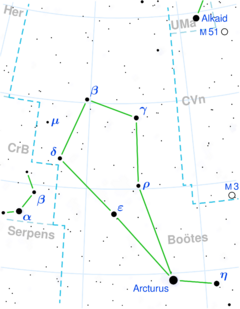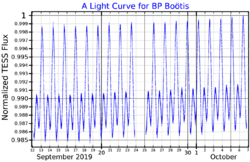BP Boötis
Topic: Astronomy
 From HandWiki - Reading time: 4 min
From HandWiki - Reading time: 4 min
| Observation data Equinox J2000.0]] (ICRS) | |
|---|---|
| Constellation | Boötes |
| Right ascension | 15h 42m 50.760818s[1] |
| Declination | +52° 21′ 39.24441″[1] |
| Apparent magnitude (V) | 5.48[2] |
| Characteristics | |
| Spectral type | A0 Vp Si Cr[3] |
| B−V color index | −0.042±0.004[2] |
| Variable type | α2 CVn[4] |
| Astrometry | |
| Radial velocity (Rv) | −16.1±2.8[2] km/s |
| Proper motion (μ) | RA: −66.214[1] mas/yr Dec.: +29.308[1] mas/yr |
| Parallax (π) | 10.92 ± 0.18[1] mas |
| Distance | 299 ± 5 ly (92 ± 2 pc) |
| Absolute magnitude (MV) | +0.48[5] |
| Details[5] | |
| Mass | 2.58±0.07 M☉ |
| Radius | 2.7±0.2 R☉ |
| Luminosity | 65 L☉ |
| Surface gravity (log g) | 3.99±0.07 cgs |
| Temperature | 9,954 K |
| Rotation | 1.29557 days |
| Rotational velocity (v sin i) | 69[6] km/s |
| Age | 170[6] Myr |
| Other designations | |
| Database references | |
| SIMBAD | data |
BP Boötis is a solitary[9] variable star in the northern constellation of Boötes, near the northern constellation border with Draco. It is visible to the naked eye as a dim, white-hued star with an apparent visual magnitude that fluctuates around 5.48.[2] The star is located 299 light years away from the Sun based on parallax, but is drifting closer with a radial velocity of −16 km/s.[2]
This is an Ap star with a stellar classification of A0 Vp Si Cr,[3] showing abundance anomalies of silicon and chromium. It is an Alpha2 Canum Venaticorum variable that varies in brightness by 0.02 magnitude over a period of 1.3 days.[4][10] The distribution of silicon across the surface appears to be associated with the magnetic field of the star, with depleted regions appearing around the magnetic poles.[11]
BP Boötis is 170[6] million years old with a projected rotational velocity of 69 km/s,[6] having a rotation period of 1.29557 days. It has 2.6 times the mass of the Sun and 2.7 times the Sun's radius. The star is radiating 65 times the luminosity of the Sun from its photosphere at an effective temperature of 9,954 K.[5]
It was transferred from Boötes to Quadrans Muralis. Later, when the International Astronomical Union officially recognised constellations, Quadrans Muralis became obsolete, so this star was moved back to Boötes.[12]
References
- ↑ 1.0 1.1 1.2 1.3 1.4 Brown, A. G. A. (August 2018). "Gaia Data Release 2: Summary of the contents and survey properties". Astronomy & Astrophysics 616: A1. doi:10.1051/0004-6361/201833051. Bibcode: 2018A&A...616A...1G. Gaia DR2 record for this source at VizieR.
- ↑ 2.0 2.1 2.2 2.3 2.4 Anderson, E.; Francis, Ch. (2012), "XHIP: An extended hipparcos compilation", Astronomy Letters 38 (5): 331, doi:10.1134/S1063773712050015, Bibcode: 2012AstL...38..331A.
- ↑ 3.0 3.1 Abt, Helmut A.; Morrell, Nidia I. (1995), "The Relation between Rotational Velocities and Spectral Peculiarities among A-Type Stars", Astrophysical Journal Supplement Series 99: 135, doi:10.1086/192182, Bibcode: 1995ApJS...99..135A
- ↑ 4.0 4.1 Samus', N. N.; Kazarovets, E. V.; Durlevich, O. V.; Kireeva, N. N.; Pastukhova, E. N. (2017), "General catalogue of variable stars: Version GCVS 5.1", Astronomy Reports 61 (1): 80–88, doi:10.1134/S1063772917010085, Bibcode: 2017ARep...61...80S.
- ↑ 5.0 5.1 5.2 North, P. (June 1998), "Do SI stars undergo any rotational braking?", Astronomy and Astrophysics 334: 181–187, Bibcode: 1998A&A...334..181N.
- ↑ 6.0 6.1 6.2 6.3 David, Trevor J.; Hillenbrand, Lynne A. (2015), "The Ages of Early-Type Stars: Strömgren Photometric Methods Calibrated, Validated, Tested, and Applied to Hosts and Prospective Hosts of Directly Imaged Exoplanets", The Astrophysical Journal 804 (2): 146, doi:10.1088/0004-637X/804/2/146, Bibcode: 2015ApJ...804..146D.
- ↑ "BP Boo". SIMBAD. Centre de données astronomiques de Strasbourg. http://simbad.u-strasbg.fr/simbad/sim-basic?Ident=BP+Boo.
- ↑ "MAST: Barbara A. Mikulski Archive for Space Telescopes". Space Telescope Science Institute. https://mast.stsci.edu/portal/Mashup/Clients/Mast/Portal.html.
- ↑ Eggleton, P. P.; Tokovinin, A. A. (September 2008), "A catalogue of multiplicity among bright stellar systems", Monthly Notices of the Royal Astronomical Society 389 (2): 869–879, doi:10.1111/j.1365-2966.2008.13596.x, Bibcode: 2008MNRAS.389..869E.
- ↑ Watson, Christopher (January 4, 2010), "BP Boötis", AAVSO Website (American Association of Variable Star Observers), http://www.aavso.org/vsx/index.php?view=detail.top&oid=4396, retrieved 3 August 2014.
- ↑ Hatzes, Artie P. (July 1990), "The distribution of silicon on BP Boo", Monthly Notices of the Royal Astronomical Society 245: 56, doi:10.1093/mnras/245.1.56, Bibcode: 1990MNRAS.245...56H.
- ↑ Barentine, John C. (2016). The Lost Constellations: A History of Obsolete, Extinct, or Forgotten Star Lore. Springer. pp. 304. ISBN 978-3-319-22794-8. https://books.google.com/books?id=u_7NCgAAQBAJ&dq=BP+Bo%C3%B6tis&pg=PA487.
 |
 KSF
KSF

